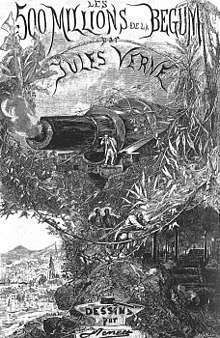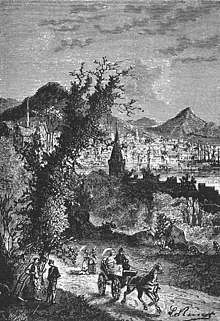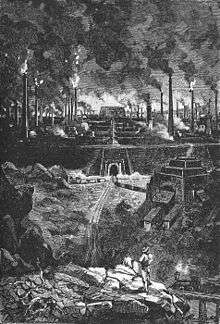The Begum's Fortune
The Begum's Fortune (French: Les Cinq cents millions de la Bégum), also published as The Begum's Millions, is an 1879 novel by Jules Verne, with some utopian elements and other elements that seem clearly dystopian. It is noteworthy as the first published book in which Verne was cautionary, and somewhat pessimistic about the development of science and technology.
 | |
| Author | Jules Verne |
|---|---|
| Original title | Les Cinq cents millions de la Bégum |
| Translator | Mrs. Agnes Kinloch Kingston and W. H. G. Kingston (1879), I. O. Evans (1958), Stanford L. Luce (2005) |
| Illustrator | Léon Benett |
| Country | France |
| Language | French |
| Series | Voyages extraordinaires #18 |
| Genre | Utopian and dystopian fiction |
| Publisher | Pierre-Jules Hetzel |
Publication date | 1879 |
Published in English | 1879 |
| Media type | Print (Hardback) |
| Preceded by | Dick Sand, A Captain at Fifteen |
| Followed by | Tribulations of a Chinaman in China |
Long after The Begum's Fortune was published, it came out that its story is based on a manuscript by Paschal Grousset, a Corsican revolutionary who had participated in the Paris Commune and was at the time living in exile in the United States and London. It was bought by Pierre-Jules Hetzel, the publisher of most of Verne's books. The attribution of plot elements between Grousset's original text and Verne's work on it has not been completely defined. Later, Verne worked similarly on two more books by Grousset and published them under his name, before the revolutionary finally got a pardon and was able to return to France and resume publication in his own name.
The book first appeared in a hasty and poorly done English translation soon after its publication in French—one of the bad translations considered to have damaged Verne's reputation in the English-speaking world. W. H. G. Kingston was near death and deeply in debt at the time. His wife, Mrs. A. K. Kingston, who did the translation for him, was certainly otherwise preoccupied than with the accuracy of the text and may have had to rely on outside help. In 2005 a new translation from the French was made by Stanford Luce and published by Wesleyan University.
I. O. Evans, in his introduction to his "Fitzroy Edition" of The Begum's Fortune, suggested a connection between the creation of artificial satellites in this novel and the publication of The Brick Moon by Edward Everett Hale in 1869.
Plot summary
Two men inherited a vast fortune as descendants of a French soldier who settled in India and married the immensely rich widow of a native prince – the begum of the title.
One of the inheritors is a French physician, Dr. Sarrasin, who has long been concerned with the unsanitary conditions of European cities. He decides to establish a utopian model city constructed and maintained with public health as its government's primary concern.
The other is a German scientist Prof. Schultze, a militarist and racist. Though having a French grandmother, he is convinced of the superiority of the "Saxon" (i.e., German) over the "Latin" (primarily, the French), which he believes will lead to the eventual destruction of the latter by the former. Schultze had published many articles "proving" the superiority of the German race. Schultze decides to make his own utopia—a city devoted to the production of ever more powerful and destructive weapons—and vows to destroy Sarrasin's city.
They both get the United States to cede its sovereignty over two cities for the creation of their utopian city-states. One is Ville-France (French: France-Ville, also translated as "Frankville") on the western side of the Cascades, and the other is Stahlstadt ("steel city"), on the east side.
Construction of Ville-France begins in January 1872, by Chinese migrant workers - who are sent away once the city is complete. The book justifies the exclusion as needed to avoid the "difficulties created in other places" by the presence of Chinese communities. This might be an oblique reference to the Chinese Massacre of 1871.
Most of the action takes place in Stahlstadt, a vast industrial and mining complex, where ores are made into steel, then made into weapons. Stahlstadt becomes in a few years the world's biggest producer of arms. Schultze is Stahlstadt's dictator, whose very word is law and who makes all significant decisions personally. There is no mention of Stahlstadt precise legal status vis-à-vis the Oregon or US Federal authorities, but clearly, Schultze behaves as a completely independent head of state.
The strongly fortified city is built in concentric circles, each separated from the next by a high wall, with the "Tower of the Bull" – Schultze's own abode – at its center. The workers are under a semi-military discipline, precisely doing metallurgical jobs. A worker straying into where and what he is not authorized to see and know is punished with immediate expulsion in the outer sectors and with death in the sensitive inner ones.
Dr. Sarrasin, in contrast, is a rather passive figure – a kind of non-hereditary constitutional monarch who, after founding Ville-France, does not take any significant decision in the rest of the book. The book's real protagonist, who actively resists Schultze, is an Alsatian, Marcel Bruckmann, native of the part of France forcibly annexed by Germany in the recent war. As an Alsatian, he is a fluent speaker of German, a requirement for entering Stahlstadt, and is able to pass himself off as being Swiss. He quickly rises high in its hierarchy, gains Schultze's personal confidence, spies out some well-kept secrets, and sends a warning to his French friends. It turns out that Schultze is not content to produce arms, but fully intends to use them first against Ville-France, then establish Germany's worldwide rule. (He casually mentions a plan to seize "some islands off Japan".)
Two weapons are being produced – a super-cannon capable of firing massive incendiary charges to Ville-France, and shells filled with gas. Schultze's gas is designed not only to suffocate its victims but at the same time also freeze them. A special projectile is filled with compressed liquid carbon dioxide that, when released, instantly lowers the surrounding temperature to a hundred degrees Celsius below zero, quick-freezing every living thing in the vicinity.
Schultze, however, meets with poetic justice. Firstly, the incendiary charge fired by the super-cannon at Ville-France not only renders the cannon unusable but also misses its mark. The charge flies over the city and into space. Secondly, as Schultze prepares orders for the final assault, a gas projectile in the office accidentally explodes and kills him.
Stahlstadt collapses since Schultze had kept everything in his own hands and never appointed any deputy. It goes bankrupt and becomes a ghost town. Bruckmann and his friend, Dr. Sarrasin's son, take it over. Schultze would remain forevermore in his self-made tomb, on display as he had planned to do to his foes, while the good Frenchmen take over direction of Stahlstadt in order to let it "serve a good cause from now on.", its arms production being used to defend Ville-France.
Setting


The precise location given for Ville-France (43°11′3″N 124°41′17″W) would place it in the Pacific Ocean off the coast of Oregon. The nearest point on the coast (43°11′3″N 124°24′07″W) would be near the mouth of Cut Creek, north of Bullards Beach State Park. The location is described as "on the shores of the Pacific Ocean, and at the foot of the secondary chain of the Rocky Mountains, called the Cascade Mountains, sixty miles to the north of White Cape, Oregon State, North America" (original French: "au bord de l'océan Pacifique et au pied de la chaîne secondaire des montagnes Rocheuses qui a reçu le nom de Monts-des-Cascades, à vingt lieues au nord du cap Blanc, Etat d'Oregon, Amérique septentrionale"). Sixty miles to the north of White Cape, or more properly, twenty metric leagues, would place it somewhere between Hauser, Oregon and Charleston, Oregon, near the inlet of Coos Bay.
The location of Stahlstadt is less clear. It is "in the United States, to the south of Oregon, ten leagues from the shores of the Pacific. The district is mountainous, its northern limits as yet barely defined by the two neighboring powers." This would place it in the vicinity of Patrick Creek, California, near the Oregon border, unless Verne's phrase ("au sud de l'Oregon") should be taken as "in the south of Oregon." When Prof. Schultze threatens to launch a bomb from Stahlstadt to Ville-France, he says, "one of these shells … will cross the Cascade mountains. Where? There exists a city, separated from us by at most thirty miles, upon whose inhabitants it will come like a thunder-clap…." The Pacific Coast can hardly be described as "at the foot of" the Cascades, which are some one hundred miles from the ocean. It is possible that Verne confused the Cascade Range with the Oregon Coast Range, in which case Stahlstadt might lie somewhere to the west of Roseburg, Oregon.
Influence, commentary, and appraisals
The mention of the gas shells seems to give Verne credit for the very first prediction of chemical warfare, nearly twenty years before H. G. Wells's "black smoke" in The War of the Worlds.
The book was seen as an early premonition of the rise of Nazi Germany, with its main villain being described by critics as "a proto-Hitler".[1] It reflects the mindset prevailing in France following its defeat in the Franco-German War of 1870-1871, displaying a bitter anti-German bias completely absent from pre-1871 Verne works such as Journey to the Center of the Earth where all protagonists (save one Icelander) are Germans and quite sympathetic ones. In his extensive review of Verne's works, Walter A. McDougall commented with the regard to The Begum's Millions: "After the Franco-Prussian War, Verne began to invent mad scientists and evil geniuses".[2]
Throughout the book, Verne repeatedly ridicules Schultze's racist ideas and their author (the word "Vaterland" in German continually occurs within the French rendering of Schultze's diatribes). As reviewer Paul Kincaid points out, Verne's ridiculing of the German's ethnic stereotyping can be regarded as itself part of an ethnic stereotyping in the opposite direction.[3]
A more obvious ethnic stereotyping is the repeated references to Schultze eating nothing but sausages and sauerkraut in enormous quantities, washed down by huge mugs of beer – even after becoming one the richest people in the world, who could afford any kind of delicacies. One scene has him commiserating with the benighted nations that are denied the benefits of the above-mentioned foods. For his part, the disguised French spy Bruckmann heartily loathes the same kind of food, but dutifully ingests it day after day in the patriotic interest of gaining Schultze's confidence – somewhat ironic, as both ingredients are quite common in Alsatian cuisine, and in combination as choucroute garnie now a common dish across France.
The book, in Hebrew translation, enjoyed some popularity in 1950's Israel. The depiction of Schultze and the divine retribution that eventually overtake him were very much in tune with prevailing Israeli attitudes at the time. Following the Holocaust, Israeli Jews had an even stronger reason to be bitter at Germans than French people of the 1870s. However, the Hebrew version omitted a passage in the original (Chapter 11) where Octave Sarrasin, the doctor's dissolute son, is being cheated by "foreigners with long noses" as well as ones belonging to "the black and yellow races."
- A passage in the book is clearly intended as satire of the already formidable American advertising industry. When looking for manpower to build their Utopian new city, the founders of Ville-France find it sufficient "to publish daily ads in all of San Francisco's 23 daily papers, and to have a special wagon completely covered with advertisements attached to the Transcontinental trains" and they "find unnecessary" the "quite cheap offer of an advertising agency to inscribe advertisements into the flanks of the Rocky Mountains." Verne's idea here anticipates Robert A. Heinlein's own in "The Man Who Sold the Moon" to use the surface of the Moon as "a billboard for Coca-Cola which would be visible from everywhere on Earth."
- At the time of writing, public opinion in France was moved by the liberal subscriptions made by the citizens of San Francisco to a relief fund for the sick and wounded soldiers of France during the Franco-Prussian war. In acknowledgement, the French government donated to the newly established San Francisco Art Association a collection of copies from original marbles in the Louvre, including twenty-five pieces of the Parthenon frieze.[4] This may have affected Verne's choice of the US Pacific Coast as a congenial setting for his ideal French city.
Common themes with Facing the Flag
Researcher George Klein noted that "The Begum's Fortune shares its main theme with Verne's Facing the Flag (Original French title: Face au drapeau), published in 1896: French patriotism faced with the threat of futuristic super-weapons (what would now be called weapons of mass destruction) and emerging victorious".[5] In both books, a symbolic extension of France (the Utopian community of Ville-France in the one book, a French warship is in the other) is threatened with a fearsome WMD and seems doomed, only to be saved in the last moment. In the one book the weapon is created by a sworn and fanatic enemy of France, who is destroyed by his own weapon; in the other, it is the creation of a renegade Frenchman, who at the moment of truth returns to his allegiance and destroys his weapon and himself rather than shoot on the Tricolour. Either way, both books end – and are clearly designed to end – with the material and moral victory of France.
Autobiographical influence
Verne's depiction of Dr. Sarrasin's "prodigal son," Octave Sarrasin (initially a weak character who is kept from moral degradation only by the leadership of his friend Marcel) is reminiscent of the writer's own strained relationship with his son Michel. As Marcel departs into United States and ultimately into Steel City, Octave, deprived of Marcel's guidance, with the newly inherited riches at hand, is allowed to follow his own frivolous ways. However, having wasted much of his father's fortune and finally realizing the absurdity of his existence, Octave arrives at Ville-France (much to the joy of his parents), reunites with Marcel and becomes his courageous and trusted companion.
Film adaptations
- Tajemství Ocelového města (The Secret of Steel City), a 1979 movie made in former Czechoslovakia, directed by Ludvík Ráža.
See also
- "Sultana's Dream", a 1905 utopian feminist Bengali science fiction short story by Begum Rokeya Sakhawat Hussain
References
- "Michael Dirda - Michael Dirda". Washingtonpost.com. 2006-03-05. Retrieved 2014-05-11.
- "Journey to the Center of Jules Verne… and Us" Archived August 8, 2006, at the Wayback Machine
- Rodger Turner. "The SF Site Featured Review: The Begum's Millions". Sfsite.com. Retrieved 2014-05-11.
- "The California School of Design: Supplement of the Mark Hopkins Institute Review of Art". Sunsite.berkeley.edu. Retrieved 2014-05-11.
- Dr. George V. Klein, "19th Century Notions of Patriotism and Nationalism and Their Long-Term Implications" in Tamara Brown (ed.) "The Road to 1914 and Thence to 1939"
External links
| Wikimedia Commons has media related to The Begum's Fortune. |
- Les Cinq cents millions de la Bégum at Project Gutenberg (in French)
Versions
- The Begum's Fortune, scanned book via Internet Archive, illustrated. Translated by W. H. G. Kingston Considered a poor translation.
Resources